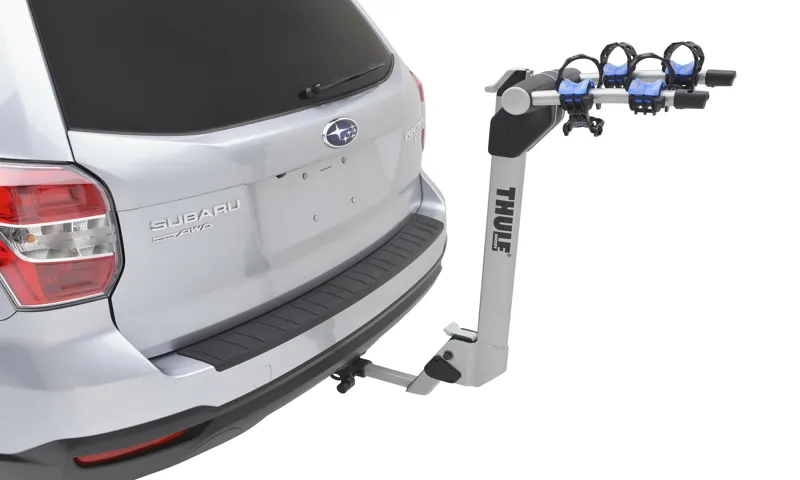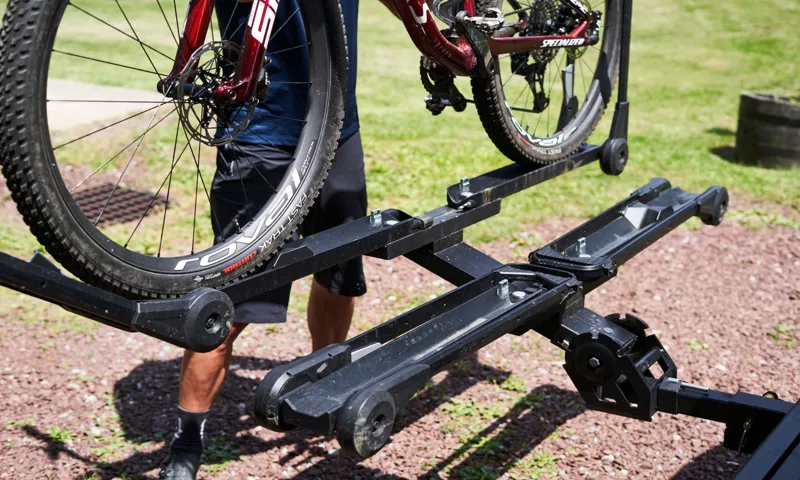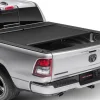Are you an avid cyclist who loves to hit the road on two wheels? If so, then you probably know the importance of having a reliable bike carrier to transport your beloved bicycle safely. However, while having a bike carrier is great, it’s also crucial to ensure that it is securely attached to your vehicle’s hitch. After all, you wouldn’t want your expensive bike to go flying off while you’re cruising down the highway, right? In this blog post, we will discuss how to lock your bike carrier to the hitch to provide that extra layer of security for your bike.
We will explore various methods and techniques that you can use to keep your bike carrier firmly in place, giving you peace of mind during your travels. Imagine your bike carrier as the lock on a treasure chest. It holds the key to your adventures, and you want to make sure it’s securely fastened.
Just like a lock keeps your treasure safe, properly locking your bike carrier to the hitch ensures that your bike is protected from theft or damage. It’s a simple yet effective way to safeguard your investment and enjoy worry-free biking trips. So, whether you’re planning a weekend getaway or a cross-country road trip, proper hitch lock techniques are essential.
We will cover everything from using hitch pins and locks to securing straps and cables. With these tips and tricks, you’ll have the knowledge and tools you need to keep your bike carrier locked in place and your bike secure. No more worrying about wobbly carriers or potential thefts – it’s time to hit the open road with confidence.
So, let’s dive into the world of hitch locks and ensure that your bike carrier is locked down tight, ready for your next cycling adventure!
Table of Contents
Section 1: Understanding the Importance of Locking Your Bike Carrier
When it comes to transporting your bike on a car or truck, it’s important to secure it properly to prevent theft or damage. One way to do this is by locking your bike carrier to the hitch. By doing so, you can deter potential thieves and keep your bike safe while on the road or parked.
So, how do you lock your bike carrier to the hitch? Well, it’s as simple as using a hitch lock. A hitch lock is a device that fits into the hitch receiver and prevents anyone from removing the bike carrier without the key. It’s like having a lock on your front door – it adds an extra layer of security and gives you peace of mind.
By taking the time to lock your bike carrier to the hitch, you can ensure that your bike stays where it belongs, allowing you to enjoy your ride without worry. So, don’t forget to invest in a hitch lock and keep your bike safe during transportation.
Importance of bike carrier security
bike carrier security, lock your bike carrier

Types of locks for bike carriers
bike carriers, locking bike carriers, types of locks for bike carriers Section 1: Understanding the Importance of Locking Your Bike Carrier When it comes to transporting your beloved bike, a bike carrier is an essential accessory. Not only does it provide a safe and convenient way to transport your bike, but it also allows you to explore new places and go on thrilling adventures. However, it’s important to remember that bike carriers are not immune to theft.
That’s why it’s crucial to invest in a reliable lock for your bike carrier. Think of it this way: your bike carrier is like a bodyguard for your bike. It protects your bike from potential damage during transportation and keeps it securely in place.
But just like any bodyguard, your bike carrier needs its own form of protection. That’s where a lock comes in. A lock acts as a shield, preventing unauthorized access and deterring thieves from trying to steal your bike carrier.
Now, you might be wondering what types of locks are available for bike carriers. There are several options to choose from, each with its own advantages and disadvantages. One popular option is the cable lock, which is made of flexible steel cables that can be easily threaded through the bike carrier and around your bike.
Another option is the U-lock, which is a rigid lock in the shape of a U. It provides a high level of security and is difficult to cut through. In addition to these options, there are also wheel and hitch locks that specifically target certain parts of the bike carrier.
These locks provide an extra layer of security and prevent thieves from easily removing your bike carrier from your vehicle. Ultimately, the type of lock you choose will depend on your specific needs and preferences. In conclusion, locking your bike carrier is just as important as locking your bike.
Risk of theft without a lock
bike carrier, theft, lock
Section 2: Steps to Lock Your Bike Carrier to the Hitch
Locking your bike carrier to the hitch is an important step in ensuring the security of your bikes while traveling. Here are some steps to follow to lock your bike carrier to the hitch. First, make sure you have a sturdy and reliable bike lock.
This will help deter thieves and provide an extra layer of security. Next, position the bike carrier on the hitch and align the holes on the carrier and the hitch. Insert the locking pin through the holes to secure the carrier to the hitch.
Tighten the pin using the provided wrench or tool. Once the carrier is securely attached, loop the bike lock around the hitch and through the frame of the carrier. Lock the bike lock and ensure that it is tightly secured.
This will help prevent the carrier from being detached or stolen. Finally, double-check that everything is locked and secure before hitting the road. Taking these steps will give you peace of mind knowing that your bikes and carrier are protected while you travel.
Step 1: Choose a high-quality lock
In this section, we will talk about the steps to lock your bike carrier to the hitch. Step 1 is choosing a high-quality lock. This is crucial because it determines the security of your bike carrier.
Look for a lock that is made from sturdy materials, such as hardened steel, to prevent it from being easily cut or broken. A high-quality lock will also have a secure mechanism, such as a complex key or combination system, to deter thieves from attempting to unlock it. Remember, investing in a good lock is essential to protect your bike carrier and prevent theft, so take the time to choose one that meets your needs.
Step 2: Position your bike carrier properly
Securing your bike carrier properly to the hitch is essential to ensure the safety of your bikes during transit. To do this, start by positioning the carrier so that it is centered and level with the hitch. This will help distribute the weight evenly and prevent any unnecessary strain on the hitch or carrier.
Once you have aligned the carrier, secure it tightly using the provided lock or hitch pin. This will prevent the carrier from wobbling or moving while you are driving. Additionally, make sure to double-check that the lock or pin is fully engaged and locked into place.
The last thing you want is for your carrier to come loose while you are on the road. By following these steps, you can have peace of mind knowing that your bike carrier is securely attached to the hitch and ready for your next adventure.
Step 3: Insert the lock through the hitch and the bike carrier
One important step in securely locking your bike carrier to the hitch is inserting the lock itself. This lock serves as a safeguard against theft, ensuring that your bike carrier remains securely attached to your vehicle. To do this, simply insert the lock through the hitch receiver on your vehicle, as well as through the designated hole on your bike carrier.
This will keep the two components tightly connected and prevent any unwanted detachment. Make sure to choose a lock that is sturdy and resistant to cutting or tampering. It’s also a good idea to position the lock in a way that it is not easily accessible or visible, further deterring potential thieves.
By taking this simple step, you can have peace of mind knowing that your expensive bike carrier is well protected.
Step 4: Secure the lock
Now that you have securely attached your bike carrier to the hitch, it’s time to take the next step to ensure the safety of your bikes – securing the lock. This is an important step to protect your valuable bikes from theft. One option is to use a cable lock to secure your bikes to the carrier.
This will prevent anyone from easily removing the bikes from the carrier. Make sure to loop the lock through the frame of each bike, as well as the carrier itself. Another option is to use a hitch lock.
This lock is inserted into the hitch receiver, preventing anyone from removing the entire carrier from your vehicle. By combining these two types of locks, you can provide an extra layer of security for your bikes. Remember, always choose a strong and sturdy lock to ensure maximum protection.
Section 3: Tips for Extra Security
When it comes to keeping your bike carrier secure on your hitch, there are a few tips to keep in mind. First and foremost, make sure the bike carrier is properly attached and secured to the hitch. Check the tightness of the bolts or pins regularly to ensure everything is still in place.
Additionally, invest in a hitch lock or locking pin to prevent anyone from easily removing the bike carrier from your hitch. These locks can provide an extra layer of security and give you peace of mind when leaving your bike unattended. Another tip is to park your vehicle and bike carrier in a well-lit and visible area.
This can help deter potential thieves and make it more difficult for them to target your bike carrier. Lastly, consider using a cable or chain lock to secure your bikes to the bike carrier. This can add an extra level of security and make it more difficult for someone to steal your bikes off the carrier.
Taking these extra precautions can help ensure the safety and security of your bike carrier and bikes while out and about.
Use additional cable or chain locks
One additional step you can take to enhance the security of your bike is by using additional cable or chain locks. While a U-lock is a great option for securing your bike, it never hurts to add an extra layer of security. Cable or chain locks are flexible and typically longer than a U-lock, allowing you to secure your bike to various objects such as lampposts, fences, or bike racks.
By using multiple locks, you make it more difficult for a potential thief to steal your bike as they would have to go through multiple obstacles. Think of it like adding multiple locks to a door – the more locks there are, the more time and effort it would take for someone to break in. So, invest in a sturdy cable or chain lock and use it in combination with your U-lock for added peace of mind.
Secure your bikes to the carrier
One important aspect of securing your bikes to the carrier is to use extra security measures to prevent theft. While most bike carriers come with built-in locks, it is always a good idea to take additional steps to ensure the safety of your bikes. One way to do this is by using a sturdy bike lock to secure the bikes to the carrier itself.
This will provide an extra level of security and make it much more difficult for potential thieves to steal your bikes. Additionally, you can also consider using a cable lock to attach the bikes to a fixed object, such as a pole or a bike rack, when you are parked and not actively using the bikes. This will further deter thieves and provide peace of mind knowing that your bikes are safely secured.
Remember, investing in extra security measures is always worth it to protect your valuable bikes.
Park in well-lit areas
Park in well-lit areas to enhance your safety and security. When you leave your car in a dimly lit spot, it not only makes it easier for potential criminals to approach unnoticed, but it also increases the chances of your vehicle becoming a target. By choosing to park in well-lit areas, you create a deterrent for thieves and make it more difficult for suspicious activity to go unnoticed.
Well-lit parking areas provide better visibility, reducing the risk of someone tampering with your vehicle or attempting to break in. Additionally, if there are security cameras in the vicinity, they are more likely to capture any criminal activity, providing evidence that can help law enforcement apprehend the perpetrators. Remember, always prioritize your safety by parking in areas that are well-lit, giving yourself an added layer of protection and peace of mind.
Consider using a hitch lock
hitch lock If you’re looking for an extra layer of security for your vehicle or trailer, consider using a hitch lock. This small but mighty device can prevent someone from attaching your trailer to their vehicle and driving off with it. A hitch lock works by securing the hitch to the receiver, making it virtually impossible for a thief to remove without the key.
It’s a simple yet effective way to protect your investment and give yourself peace of mind. So whether you’re using your trailer for camping trips or hauling valuables, a hitch lock is a worthwhile investment to deter theft and keep your belongings safe. Plus, they’re easy to use and affordable, making them a practical choice for anyone in need of extra security.
So why take the risk when you can easily safeguard your trailer with a hitch lock?
Section 4: FAQs about Bike Carrier Locking
One common concern among bike owners is how to properly secure their bike carrier to their hitch. Many people worry about the possibility of their bike carrier being stolen or tampered with while they are away. Thankfully, there are several ways to lock a bike carrier to a hitch to provide peace of mind.
One option is to use a hitch pin lock, which fits into the hitch receiver and prevents the bike carrier from being removed without a key. Another option is a cable lock or bike lock that can be threaded through the bike carrier and hitch to prevent anyone from detaching the carrier. These locks are typically made of durable, weather-resistant materials to withstand outdoor conditions.
It is important to also choose a lock that is compatible with your specific bike carrier and hitch to ensure a secure fit. By taking these precautions, you can protect your bike carrier from theft and enjoy worry-free travels.
Can I use any type of lock for my bike carrier?
When it comes to locking your bike carrier, it’s important to choose a lock that is suitable for the job. While any type of lock can technically be used, not all locks are equally effective or secure. It’s recommended to use a lock specifically designed for bike carriers, such as a cable lock or a U-lock.
These locks offer a higher level of security and are more difficult for thieves to tamper with. They also typically have features such as anti-drilling and anti-picking mechanisms to provide additional protection. Additionally, these locks are designed to fit securely around the bike carrier and bike frame, ensuring that they cannot be easily removed or stolen.
So, while you could technically use any type of lock, it’s best to invest in a lock specifically designed for bike carriers to ensure the safety and security of your equipment.
How much should I tighten the lock?
bike carrier lock, tighten the lock, bike security
Can I lock multiple bikes to the carrier with one lock?
Yes, it is possible to lock multiple bikes to a carrier with one lock. Many bike carrier manufacturers offer options that allow for multiple bikes to be secured together using a single lock. These locks typically have multiple attachment points or arms that can hold the bikes in place while they are being transported.
It’s important to check the specifications of the bike carrier and lock to ensure that they are compatible and can securely hold multiple bikes. Additionally, it’s a good idea to use additional locks or cables to secure each bike individually to the carrier for extra security. So, whether you’re heading out on a biking adventure with friends or family, you can rest assured knowing that all of your bikes can be safely locked and transported on a bike carrier.
Do I need to remove the lock before using the carrier?
No, you do not need to remove the lock before using the carrier. In fact, many bike carriers come with built-in locking mechanisms that allow you to secure your bike to the carrier without the need for an additional lock. This can provide added peace of mind, knowing that your bike is secure while being transported.
However, if your carrier does not have a built-in lock, or if you prefer to use an additional lock for added security, you can certainly leave the lock attached to your bike while using the carrier. Just make sure that the lock does not interfere with the proper installation and function of the carrier. It’s always a good idea to double-check the instructions provided with your specific carrier to ensure that you are using it correctly and securely.
So, whether you choose to use a separate lock or rely on the integrated locking mechanism, your bike can be safely transported on a carrier without the lock needing to be removed.
Conclusion
In conclusion, securing your bike carrier to your hitch is not only important for the safety and security of your bicycles, but also for the peace of mind in knowing that they are locked up tight. You wouldn’t leave your bike unlocked out on the streets, so why leave your bike carrier vulnerable to theft? By following these simple steps and investing in a high-quality hitch lock, you can ensure that your bike carrier stays put and your bikes stay safe. Remember, a hitch lock is like a superhero cape for your bike carrier – it keeps your bikes protected and your adventures uninterrupted.
So, don’t be a “bike-napper’s” dream. Take the time to lock up your bike carrier properly, so you can pedal off into the sunset with confidence and style. Happy cycling, and may your hitch lock be as strong as your quads!”
FAQs
How do I lock a bike carrier to a hitch?
To lock a bike carrier to a hitch, you can use a hitch lock. These locks are designed to secure the carrier to the hitch, preventing theft or unauthorized removal. Simply insert the lock into the hitch receiver and secure it using the provided key or combination.
What is the purpose of locking a bike carrier to a hitch?
Locking a bike carrier to a hitch ensures the security of your bikes during transport. It prevents theft or accidental detachment of the carrier from the vehicle. By using a hitch lock, you can have peace of mind knowing that your bikes are safely secured during transportation.
Can any lock be used to secure a bike carrier to a hitch?
It is recommended to use a hitch lock specifically designed for securing bike carriers to hitches. These locks are made of durable materials and are designed to fit securely into the hitch receiver. Using a lock that is not specifically designed for this purpose may not provide adequate security.
How do I choose the right hitch lock for my bike carrier?
When choosing a hitch lock for your bike carrier, consider the size of your hitch receiver and the type of lock mechanism you prefer. Hitch locks come in various sizes to fit different hitch receivers, so make sure to choose one that matches your hitch size. Additionally, you can choose between key-operated locks or combination locks based on your personal preference.
Are hitch locks compatible with all types of bike carriers?
Hitch locks are generally compatible with most hitch-mounted bike carriers. However, it is always recommended to check the compatibility of the lock with your specific bike carrier model. Some carriers may have unique designs or dimensions that require specific hitch locks for proper fitment and security.
Can a hitch lock be used as the sole security measure for a bike carrier?
While hitch locks provide an additional layer of security, it is not recommended to rely solely on them for protecting your bike carrier. It is always best to use multiple security measures, such as cable locks or bike locks, to secure the bikes themselves to the carrier. This way, even if the hitch lock is compromised, the bikes will still be securely attached.
How often should I check the hitch lock during transport?
It is good practice to periodically check the hitch lock during your journey to ensure it remains secure. Vibrations and movement during travel can sometimes loosen the lock, so it’s important to verify its tightness. If you notice any looseness or if the lock appears to be compromised, take the necessary steps to re-secure it or replace it if needed.



